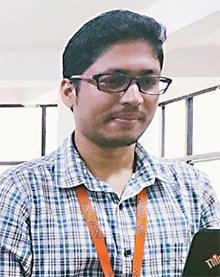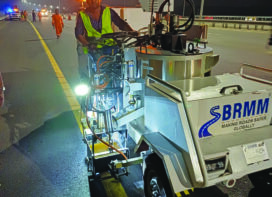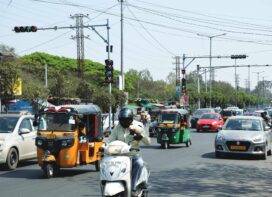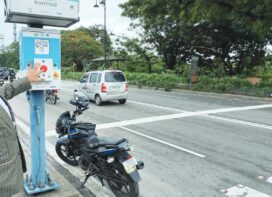 Subodh Kumar Sharma, Co-founder & CEO, Innovary Technologies – India, explained, “The ecosystem of data-driven road safety revolves around the data used to make decisions. Data must be result oriented to improve road safety. The only vision of datadriven road safety is to ensure that no one would be killed or injured on the road. Data-driven result improves the road safety with respect to the number of vehicles.
Subodh Kumar Sharma, Co-founder & CEO, Innovary Technologies – India, explained, “The ecosystem of data-driven road safety revolves around the data used to make decisions. Data must be result oriented to improve road safety. The only vision of datadriven road safety is to ensure that no one would be killed or injured on the road. Data-driven result improves the road safety with respect to the number of vehicles.
Day-by-day, the government is implementing new rules and regulations to focus on dataoriented road safety. They are making changes in the driving License Act and making the new drivers more educated on traffic rules. Below are the few preconditions implemented by government to improve road safety through the data..
• Implementing precondition for automated vehicles before moving onto the road.
• Fining procedure to increase awareness and promote road safety.
• Vehicle inspection requirements to monitor the health of vehicles in order to reduce the risk to road safety.
• By improving and reforming the skills and abilities of drivers. This reformation on training will improve citizen’s abilities to drive safely on road.
• Continuous improvement and monitoring of traffic equipment used in Traffic Signals, etc
• Traffic infrastructure like construction of roads, bridges, flyover, sidewalks, etc. must be constructed based on the vehicular and pedestrian data collected by Traffic Data Collection companies.
Challenges in gathering the data
 Sharma believes that traffic data is the heart of transport projects and road safety. But it is not easy to collect the accurate, comprehensive, appropriate, result-oriented, and cost-effective traffic data. So, most of the transport professional relay on the old or traditional way of data collection procedures. Due to lack of inadequate data tools and budget, it is hard to get the exact traffic pattern and thus the data driven road safety. These are not the only challenges, but political priorities are also becoming the big challenges in certain areas and overshadow the real-world data.”
Sharma believes that traffic data is the heart of transport projects and road safety. But it is not easy to collect the accurate, comprehensive, appropriate, result-oriented, and cost-effective traffic data. So, most of the transport professional relay on the old or traditional way of data collection procedures. Due to lack of inadequate data tools and budget, it is hard to get the exact traffic pattern and thus the data driven road safety. These are not the only challenges, but political priorities are also becoming the big challenges in certain areas and overshadow the real-world data.”
To move into the real time traffic data insights, transport planners must change the way they collect the data. The procedure of data collection should be standard and must adhere with the ISO. Only qualified and experience team can help to achieve this. The accuracy of traffic data collection and the subsequent predictions are of paramount importance in the fulfilment of an appropriate planning, design, maintenance monitoring and management of the road network and road safety. The major fields where this data is required are; Road Safety measures, Traffic Control, Transport Statistics, and Planning design and project initiations.
Data-driven road safety management is common practice when designing and implementing a road safety strategy. It includes clearer rules of the road, more efficient traffic control, increasing the number of safer vehicles and preparing the ground for automatic transport, securing the safety of the road network, reforming the driving instruction and driving test system as well as reducing drink driving and other factors. This is of course the most important thing when it comes to countries like India.
Sharma said, “First of all, India is a developing country where data driven safety strategies are very slow. Currently, our transport professionals are trying to implement the standard procedures. Still, we are not as good as other developed countries that are in this domain. In India, our government agencies follow a lengthy and most complicated strategies to move into data driven road safety management.
“Even our country has similar traffic rules like other developed countries have. But our government and citizens are not serious to implement and follow these things. We have clearer rules of the road, reforming the driving instruction, more efficient traffic control, securing the safety of the road network, and driving test system as well as reducing drink driving and other factors. All these common rules are not followed at major level but by few citizens only. Due to uneducated drivers and pedestrian, it is quite impossible. So education program for drivers and pedestrian must be provided to reduce the crash rate. Apart from this, some additional work needs to be done on rural and urban infrastructure design like service lanes along all intercity highway, roundabout or circular junctions, safer zebra crossing at each junction or intersection etc.”
in India is also on the peak level and contributes to the increase of Traffic jams, accident etc. Most of the countries has specific rules on personal vehicles. We need to be more professional while driving or moving on roads and should increase awareness among people. In case of India, we do not have advance technologies to cover up safety related issues. The data is still collected in a traditional way that are time consuming and not relevant as the modern technologies. There are limited and qualified professionals in this domain to gather data. Moreover, there is a need to provide education to our youngsters and motivate them to pursue careers in transportation engineering. Education on transportation and implementation of new technologies can change our lives or we can say reduce the number of data-driven safety issues.
 TrafficInfraTech Magazine Linking People Places & Progress
TrafficInfraTech Magazine Linking People Places & Progress


